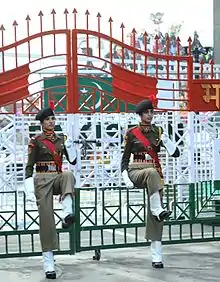Central Armed Police Forces
The Central Armed Police Forces (CAPF) refers to uniform nomenclature of five security forces in India under the authority of the Ministry of Home Affairs. Their role is to defend the national interest mainly against the internal threats. They are the Border Security Force (BSF), Central Reserve Police Force (CRPF), Central Industrial Security Force (CISF), Indo-Tibetan Border Police (ITBP), Sashastra Seema Bal (SSB).[2][3][4]
| Central Armed Police Forces | |
|---|---|
 | |
| Abbreviation | CAPF |
| Agency overview | |
| Annual budget | ₹920 billion (US$13 billion) (2020–2021)[1] |
| Jurisdictional structure | |
| Federal agency | IN |
| Operations jurisdiction | IN |
| Governing body | Ministry of Home Affairs |
| General nature | |
| Operational structure | |
| Minister responsible | |
| Agency executive | |
| Parent agency | Ministry of Home Affairs |
| Child agencies | |
| Website | |
| Official Website | |

Organisation and leadership
Central Armed Police Forces are organized with the primary role of border guarding for BSF, ITBP, SSB; Security of sensitive establishments by CISF, Assisting Police to tackle Law & Order, Counter-Terrorist Operations, Counter Naxal Operations by CRPF, NSG. Apart from the primary role, all CAPFs are involved in assisting Police in Law & Order situations and also Army in Counter-Terrorist Operations. BSF & CRPF have assisted the army during external aggression in the past. CAPFs work along with both Army & Police in different roles assigned to them.
Central Armed Police Forces personnel also serve in various important organisations such as Research and Analysis Wing (RAW), Special Protection Group (SPG), National Investigation Agency (NIA), Intelligence Bureau (IB), Central Bureau of Investigation (CBI), National Disaster Response Force (NDRF), Narcotics Control Bureau (NCB) STATE ARMED POLICE FORCE (Jharkhand jaguars,Bihar Military Police,UP/MP STF, DRG,IRB,Chatishgarh Armed Police etc.) on deputation and have attachment/training in various levels/formations/courses along with Indian Army. Their role and performance, therefore, assumes a great significance due to the special features of an emergency force which is pressed in aid to the civil power to perform multiple roles in extremely difficult situations.
Organized Group ‘A’ Service (OGAS) to Group ‘A’ Executive Cadre Officers
Supreme Court Ruling
On 5 February 2019, the Supreme Court of India ruled[5][6] that all CAPFs would be granted better pay benefits or Non-Functional Financial Upgradation (NFFU),[7] and the status of Organised Group ‘A’ Services (OGAS), ending a nearly decade-long battle for the central armed police. In a landmark judgment by Justices Rohinton Fali Nariman and M R Shah, the court said the CAPF officers–from BSF, CRPF, SSB, ITBP, and CISF– will now be granted the NFFU and will be considered as organized group A Central Services. As Assam Rifles Cadre officers are not covered under this as they do not come under categorisation of CAPFs.
Approval By Cabinet
In July 2019, Union Cabinet granted[8][9] Organized Group 'A' Service (OGAS) status to Group 'A' executive cadre officers of the Central Armed Police Forces (CAPF). It also extended the benefit of Non-Functional Financial Upgradation(NFFU) and Non-Functional Selection Grade (NFSG) to the executive cadre officers at an enhanced rate of 30%.
Recruitment, ranks and structure
Recruitment of candidates to the CAPFs may be conducted by the Union Public Service Commission, the Staff Selection Commission, or the respective service HQs depending on the post to be filled. There are three possible pathways for recruitment to the CAPFs:
Gazetted officers
Officers in CAPFs are recruited through the Central Armed Police Forces (Assistant Commandants) Examination conducted by UPSC. They are appointed as Assistant Commandants and are Gazetted Officers generally referred to as DAGOs (Directly Appointed Gazetted Officers) in CRPF, AC (Direct Entry) in BSF. DEGOs (Departmental Entry Gazetted Officers) are those officers who have been promoted through departmental exams conducted internally for Subordinate Officers.They are known as ENCOUNTER SPECIALIST among police forces of India.
Subordinate officers
Sub Inspectors are recruited through competitive examination conducted by Staff Selection Commission and they are referred to as DASOs (Directly Appointed Subordinate Officers). DESOs (Departmental Entry Subordinate Officers) are those officers who have been promoted through departmental exams conducted internally for Constables, Head Constables, and Assistant Sub Inspectors.
Constables
Constables are recruited through a competitive examination conducted by Staff Selection Commission.
Apart from the above modes, CAPFs conduct recruitment for specialized posts such as Engineers, Doctors, etc. among DAGOs and Wireless operators, Technicians, Nursing Staff, etc. among subordinate officers and constables directly under their own authority.

Women in the Central Armed Police Forces
Initially, women were not recruited for the Central Armed Police Forces. In 1992, Asha Sinha created history by being the first Woman Commandant of any of the Central Armed Forces in India when she was selected as Commandant, Central Industrial Security Force, for Mazagon Dock Shipbuilders Limited. Earlier the role of Women was allowed but limited to supervisory roles in the Central Armed Police Forces.[11] The Parliamentary Committees of India for women's empowerment recommended greater roles for women in the CAPF. On these recommendations, the Ministry of Home Affairs declared reservation for women in constabulary in paramilitary forces, and later declared that they can also be inducted as officers in combat roles in all five Central Armed Police Forces.[11] The Union Home Minister announced that women's representation in the CRPF and CISF would be made 15 percent while it would be 5 percent in the BSF, ITBP and SSB.[12] On 5 January 2016, it was decided that 33 percent of posts at the constabulary level would be reserved for women in the CRPF and the CISF to begin with, and 14-15 percent of posts at the constable level in the BSF, SSB and ITBP in a phased manner, Rijiju said. In 2016, an IPS Officer Archana Ramasundaram of 1980 Batch rewrote history when she became the first woman to become the Director General of Police of a Paramilitary Force as DG, Sashastra Seema Bal.[13]
Central Reserve Police Force (CRPF)
The Central Reserve Police Force is the largest of the Central Armed Police Forces units with 313,678 personnel in 245 battalions.[14] The Central Reserve Police includes:
- The Rapid Action Force (RAF), a 15 battalion anti-riot force trained to respond to sectarian violence.
- The Commando Battalion for Resolute Action (COBRA), a 10 battalion strong anti-Naxalite/COIN force.[15]
Border Security Force (BSF)

The primary role of the Border Security Force is to guard the Indo-Pakistan and Indo-Bangladesh borders, it is deployed both on the international border and the LOC. The BSF also has active roles during times of war. It has 257,363 personnel in 186 battalions.[16]
Central Industrial Security Force (CISF)
One of the largest industrial security forces in the world, the Central Industrial Security Force provides security to various Public Sector Undertakings (PSUs) and other critical infrastructure installations, major airports across the country and provides security during elections and other internal security duties and VVIP protection. It has a total strength of about 144,418 personnel in 132 battalions[14] including 9 reserve battalions.
Indo-Tibetan Border Police (ITBP)
The Indo-Tibetan Border Police is deployed for guarding duties on the Indo-China border from Karakoram Pass in Ladakh to Diphu Pass in Arunachal Pradesh covering a total distance of 3488 km.[17] It has 89,432 personnel in 56 fighting, 2 DM and 4 specialized battalions.[18][14]
Sashastra Seema Bal (SSB)
The objective of the Sashastra Seema Bal (English: Armed Border Force) is to guard the Indo-Nepal and Indo-Bhutan borders. It has 76,337 personnel and 67 battalions, as well as some reserved battalions.[19][14][20]
See also
References
- "MHA gets 1.67 lakh crore;emphasis on police,census".
- Government of India, Ministry of Home Affairs (18 March 2011). "Office Memorandum" (PDF). mha.gov.in. Director (Personnel), MHA. p. 1. Retrieved 19 September 2020.
- Government of India, Ministry of Home Affairs (23 November 2011). "Office Memorandum" (PDF). mha.gov.in. Director (Personnel), MHA. Retrieved 19 September 2020.
- Online, The Telegraph (26 March 2011). "For the paramilitary, all's in a new name". telegraphindia.com. The Telegraph. Retrieved 19 September 2020.
- https://indianexpress.com/article/india/sc-upholds-hc-order-on-nffu-for-capf-officers-5571027/
- https://main.sci.gov.in/supremecourt/2013/7829/7829_2013_Judgement_05-Feb-2019.pdf
- https://dopt.gov.in/sites/default/files/14017_47_2011-Estt.RR-01082012.pdf
- https://pib.gov.in/PressReleaseIframePage.aspx?PRID=1576843
- https://www.business-standard.com/article/news-ani/centre-gives-nods-to-grant-ogas-status-to-group-a-executive-cadre-officers-119070301021_1.html
- "Lt Col rank officers in armed forces placed in higher pay band". timesofindia.indiatimes.com. Times of India. 22 April 2009. Retrieved 19 September 2020.
- "Government allows women to be combat officers in all Central Armed Police Forces". The Economic Times. 11 July 2018. Retrieved 9 January 2020.
- "Women quota in CRPF, CISF to be made 15 percent". telegraphindia.com. Retrieved 9 January 2020.
- Selvaraj, A. "Archana Ramasundram becomes first woman to head paramilitary forces | India News - Times of India". The Times of India. TNN. Retrieved 9 January 2020.
- "MHA Annual Report 2016-2017" (PDF). Archived from the original (PDF) on 8 August 2017.
- "COBRA to sting Naxal virus: new force gets Centre nod". Financial Express. 29 August 2008. Retrieved 26 February 2014.
- "Border Security Force". bsf.nic.in. Archived from the original on 20 August 2014. Retrieved 19 February 2020.
- "Indo-Tibetan Border Police". Archive.india.gov.in. Retrieved 9 February 2014.
- "Home | Indo Tibetan Border Police, Ministry of Home Affairs". itbpolice.nic.in. Retrieved 10 August 2017.
- "Guarding the Nation's Frontiers | eGov Magazine". Egov.eletsonline.com. 6 March 2013. Retrieved 5 January 2014.
- "Force Profile- SSB Ministry Of Home Affairs, Govt. Of India". ssb.nic.in. Retrieved 12 August 2017.
External links
| Wikimedia Commons has media related to Central Armed Police Forces. |